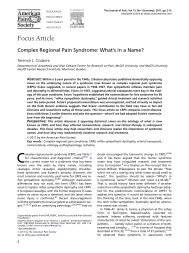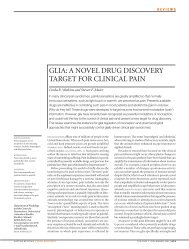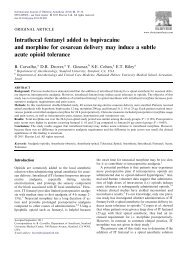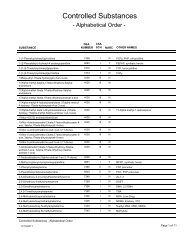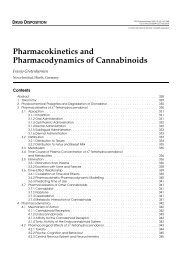1) Vitamin D For Chronic Pain - Pain Treatment Topics.org
1) Vitamin D For Chronic Pain - Pain Treatment Topics.org
1) Vitamin D For Chronic Pain - Pain Treatment Topics.org
Create successful ePaper yourself
Turn your PDF publications into a flip-book with our unique Google optimized e-Paper software.
<strong>Vitamin</strong> D for <strong>Chronic</strong> <strong>Pain</strong><br />
30 to 32 ng/mL. However, this may be inadequate.<br />
Clinical research trials have demonstrated that 1000 IU/day<br />
of vitamin D 3 produces only modest increases in 25(OH)D that<br />
can be inconsequential for achieving and maintaining optimal<br />
concentrations of 30 ng/mL or more in some persons. 26,29 Vieth<br />
and colleagues 26 demonstrated that 4000 IU/day D 3 could be<br />
safe and more effective in producing desired outcomes. Several<br />
general principles emerge from the accumulated research to<br />
date 19,21,23,25,26,39,46,100,115,116,117,118 :<br />
• Concentrations of 25(OH)D are not increased in direct<br />
proportion to the amount of supplementation increase.<br />
<strong>For</strong> example, tripling the D 3 dose—such as going from 600<br />
IU/day to 1800 IU/day—does not increase the concentration<br />
of 25(OH)D by threefold.<br />
• Any increase in 25(OH)D is also dependent on the concentration<br />
of this metabolite at the start of treatment. At<br />
equivalent vitamin D doses, patients with more severe<br />
baseline inadequacies will have larger, more rapid increases<br />
in 25(OH)D concentrations.<br />
• What might be considered large doses of vitamin D 3 by<br />
some practitioners do not produce proportionately large<br />
increases in 25(OH)D concentrations, depending on the<br />
amount of dose and duration of administration. <strong>For</strong> example,<br />
a single 50,000 IU dose of D 3 may produce a significantly<br />
smaller increase in 25(OH)D than 2000 IU given<br />
daily over time, and the increases from either of these<br />
could be modest.<br />
• However, it must be noted that continuous megadoses of<br />
vitamin D (eg, >50,000 IU) could produce robust, possibly<br />
toxic, increases in 25(OH)D concentrations over time.<br />
In everyday practice, exceptionally large daily doses of vitamin<br />
D would rarely be recommended to patients. Researchers have<br />
noted that raising 25(OH)D from 20 ng/mL to the more optimal<br />
30+ ng/mL range in otherwise healthy patients would require<br />
ongoing daily supplementation of only about 1300 IU 39 to 1700<br />
IU 119 of vitamin D 3 . However, it should be noted that the daily<br />
adequate intake of vitamin D for maintaining health is, in most<br />
cases, lower than the amount needed as therapy for patients<br />
with chronic pain.<br />
Putting “D” Into Clinical Practice. In patients with pain,<br />
researchers have examined daily vitamin D supplementation<br />
ranging from 600 IU to 50,000 IU, 19,27,116 as well as much larger<br />
amounts. Because vitamin D has a long half-life and can take<br />
several months to reach steady-state levels, one approach to<br />
supplementation has been to administer oral or intramuscular<br />
megadoses on an infrequent basis. <strong>For</strong> example, single doses of<br />
300,000 IU D 2 have been used in the expectation that they might<br />
suffice for many months. 120 Hathcock et al 121 and others 122 noted<br />
that amounts of vitamin D up to 100,000 IU would not be toxic<br />
if restricted to one administration every four months, or daily<br />
for a single period of four days.<br />
In one study of patients with chronic back pain, subjects were<br />
treated for 3 months with either 5000 IU/day or 10,000 IU/day<br />
of vitamin D 3 (heavier patients >50 kg received the larger<br />
dose), 74 There were no adverse effects reported, and pain<br />
symptoms were relieved in 95% of the patients.<br />
Despite the reported successes of larger-dose vitamin D<br />
supplementation, many healthcare providers may be uncomfortable<br />
with recommending such doses for their patients. And,<br />
TABLE 4. Recommended <strong>Vitamin</strong> D Intake in<br />
Healthy Persons<br />
1997 — Institute of Medicine<br />
200 IU/d – children and adults to age 50 years<br />
400 IU/d – men and women aged 50-70 years<br />
600 IU/d – those older than 70 years<br />
2005 — Dietary Guidelines for Americans<br />
1000 IU/d – children and adults<br />
Note: In some of the literature International Units are expressed<br />
as micrograms. The conversion formula is 1 IU = 0.025 mcg or<br />
1 mcg = 40 IU.<br />
unless pathways of vitamin D metabolism are impeded (eg, due<br />
to liver or renal disease or an interacting drug), such high doses<br />
could be unnecessary, at least as initial therapy.<br />
In patients with chronic pain, Gloth and colleagues 79 observed<br />
that symptom relief often can be achieved with relatively modest<br />
increases in 25(OH)D and 1,25(OH) 2 D concentrations. This is<br />
possibly because the vitamin D metabolites are being rapidly<br />
consumed at tissue sites and also becoming depleted in storage<br />
depots, so they cannot accumulate in needed quantities and so<br />
any added amount is beneficial. These researchers also<br />
suggested that pain syndromes may affect vitamin D receptors,<br />
causing them to become altered in function or increased in<br />
quantity (upregulated) and, thereby, physiologically requiring<br />
extra amounts of the 1,25(OH) 2 D hormone.<br />
A proposed conservative dosing protocol is outlined in Table<br />
5. This involves adding a daily supplement of 2000 IU of vitamin<br />
D 3 to a daily multivitamin regimen, bringing the total daily<br />
vitamin D 3 intake to 2400 IU to 2800 IU. This is a convenient<br />
supplement dose, since inexpensive 1000 IU D 3 tablets or<br />
capsules are readily available and some outlets are now stocking<br />
2000 IU/dose tablets. The daily cost of the supplement is<br />
typically US $ 0.10 or less.<br />
<strong>Vitamin</strong> D 3 products are preferred since they cost no more<br />
than D 2 and most research indicates that D 3 is more effective<br />
19,115,118,123 Vieth 19 has strongly urged that “all use of vitamin D<br />
for nutritional and clinical purposes should specify cholecalciferol,<br />
vitamin D 3 .”<br />
<strong>Vitamin</strong> D therapy would be contraindicated in patients with<br />
pre-existing excessive levels of calcium (hypercalcemia or hypercalcuria),<br />
and special caution might be advised in those prone<br />
to forming kidney stones or other calcifications. 12,13,121 Besides<br />
renal or hepatic dysfunction, intestinal malabsorption due to<br />
age, irritable bowel syndrome, Crohn’s disease, or celiac disease<br />
also may limit response to vitamin D therapy. 20,51,124<br />
Current therapies for chronic pain, started prior to initiating<br />
vitamin D 3 therapy, do not need to be discontinued; however,<br />
it must be accepted that it could be difficult to attribute improvements<br />
to one therapy over another. This would be confounded<br />
further if new therapies for pain are started during vitamin D 3<br />
supplementation and before enough time has elapsed to evaluate<br />
its effectiveness.<br />
If there are no improvements after several months of the<br />
proposed conservative vitamin D 3 dosing protocol, more time<br />
rather than increased doses may be necessary for vitamin D 3<br />
Practical PAIN MANAGEMENT, July/August 2008<br />
©2008 PPM Communications, Inc. Reprinted with permission.<br />
33



